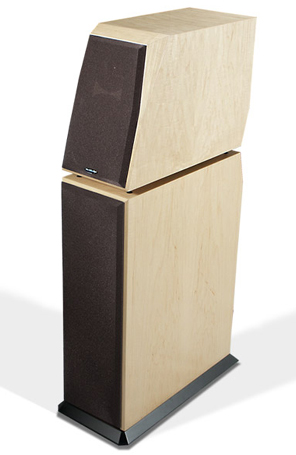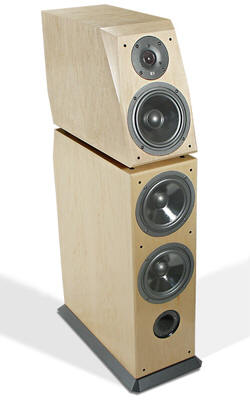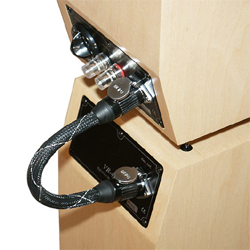You are reading the older HTML site
Positive Feedback ISSUE
17
january/february 2005
von schweikert audio
VR-4jr loudspeakers
as reviewed by Fown-Ming Tien

FOWN-MING TIEN'S SYSTEM:
LOUDSPEAKERS
ELECTRONICS
SOURCES
CABLES
ACCESSORIES
|
Every year, as the Consumer Electronics Show approaches, a buzz begins to build about certain products. Last year, the buzz was about a pair of under-$4000 speakers from Von Schweikert Audio. The pre-show hype caught my attention, so I put the VSA VR-4jrs on my list of must-see products. When I finally heard them, I was not impressed. They sounded heavy, thick, and muddy. Why would a manufacturer produce speakers that sounded this horrible? Were my preferences (or hearing) that much different from the designer's? Perhaps the speakers did not work well in that room? Or the front end was not a good match for the speakers? Was this true audiophile sound, yet I was not sophisticated enough to appreciate it? I was befuddled by what I heard.
Fast forward to a meeting of the Los Angeles and Orange County Audio Society in April 2004, which featured Von Schweikert's $2500-per-pair VR-2s. Given my response to the VT-VR-4jrs, you can imagine how surprised I was when the VR-2s began playing and my toes began tapping! The 2s sounded nothing like what I had heard at CES from their big brothers. Kevin Malmgren, Vice President of Von Schweikert Audio, told me that there were some technical issues at CES that prevented the VR-4jrs from shining. Having learned this, I naturally wanted to hear them again.
By coincidence, I had just moved only a few miles away from the Von Schweikert facility, so I swung by one evening after work to hear the VR-4jrs again. This time, the speakers exceeded my expectations. The listening room at Von Schweikert headquarters was rather large, and the VR-4jrs effortlessly filled it with a wonderfully musical yet balanced sound. Kevin told me that they were not fully broken in, and would improve when they were given more playing time and each bass module was mass-loaded with fifty pounds of lead shot. I could not imagine that they could sound better, but wanted to hear them in my own listening room before determining how much value they offered—$3995 represents a substantial amount of dough for most folks, myself included!
Fast-forward again. Demand for the 4jrs had been so high that review samples were not available until August. I again swung by after work, loaded up the two large, heavy cardboard boxes, and headed home. Opening the boxes, I discovered that underneath the outside layer of cardboard was a wooden crate that protected the speakers from shipping damage. Inside the crate, the speakers were surrounded by high-density foam. The bass and midrange/tweeter modules came in their own velvet storage bags—a very nice touch! While the packing of these speakers is the best I have seen, the downside is that the boxes weigh more than 130 pounds apiece. You'll definitely need a dolly and/or a friend to help move them around. Fortunately, because each speaker consists of two pieces, unpacking them is infinitely easier than it would be if they were single units. Two instruction sheets accompany the speakers, one for unpacking the speakers and the other for setting them up.

Like many of the Chinese-built speakers I have seen, the VR-4jrs have a high level of fit and finish. The review pair came with beautiful book-matched maple veneers. The connectors are nice five-way binding posts made of Rhodium. There are two 7-inch mica-cellulose polylaminate woofers in each bass module, which is a triple-chambered transmission line design tuned to 25Hz. One-inch MDF is used throughout. Each midrange/tweeter module has three drivers—a 1-inch fabric dome tweeter, a 7-inch midrange driver, and a rear-firing 1-inch fabric dome tweeter for ambience retrieval.
I placed the speakers approximately 8 feet apart, about 30 inches from the front wall and 24 inches from the side walls, with the tweeters aimed at my shoulders. I connected speaker cables to the upper pair of binding posts on the bass module, linking the satellite using the supplied data link cable. Although Kevin had made a point of telling me that the VR-4jrs would require 400 hours of break-in time, I fired up my system expecting to have a revelation. To my dismay, the 4jrs were not impressive. They sounded good, but not how I remembered them sounding in the Von Schweikert listening room.
In hindsight, this was fortunate. Had the VR-4jrs lived up to my expectations immediately, I would not have learned much about them. Not getting the results I expected forced me to try a variety of system configurations, which allowed me to discover how incredible these speakers really are. With most speakers, I had found that 100 hours was plenty of break-in time. With the VR-4jrs, I discovered that 400 hours was not too much. In the past, I usually found that the bass frequencies were the last to fill in, as the woofers required the most time to loosen up. The VR-4jrs had very good bass after 100 hours, and it was the tweeters that took the longest time to settle down. I was still hearing tizziness until approximately the 300-hour mark, at which point the highs and lows were not bad, but the all-important midrange was recessed and cool. What changed during the three months of the review period, in which the VR-4jrs went from forgettable to the very top of my speaker list? Quite a lot!

When I called Kevin and shared my initial disappointment, he was puzzled. He stressed that the VR-4jrs are extremely neutral, transparent, and revealing of any and all upstream weaknesses, so we began going through all of the variables in my system. CD transport… check. DAC… check. Digital cable… check. Preamp… check. Amps… check. Running out of ideas, Kevin again urged me to give the speakers more break-in time. Finally, he asked which method I was using to connect the speakers. As the last four pairs of speakers I had tried could only be single-wired, I did not consider the effects of bi-wiring. Kevin informed me that using the data link and upper binding posts on the bass module was one of the least preferred methods of hooking up the VR-4jrs. (The setup sheet covers this, but in my initial excitement, I had neglected to read it.) The data link is for those folks who desire a clean look behind the speakers, but will not give the best sonics. Luckily, I had an extra pair of Cryotweaks Trinity speaker cables to use for bi-wiring the bass module, and my Aragon amps had a second pair of binding posts that I could use to connect speaker cables to the midrange/tweeter modules. This task was handled by a pair of Eichmann eXpress6 Series2 speaker cables that I was in the process of reviewing.
When I fired up my system after these changes, what I heard was more to my liking. Bi-wiring opened up the sound across the board. The highs were more airy and transparent, the midrange much more musical and engaging. The bass was thunderous and articulate. I played Beethoven's Fifth Symphony conducted by Herbert Von Karajan, which had sounded clinical and unemotional when I was using the data link. This time, all the passion of the piece was present in full force. I now had an inkling of how transparent and revealing the VR-4jrs were, but my experiments with component changes in the next few months allowed me to appreciate just how neutral and transparent these speakers are.
I found the rear-firing ambience tweeters to be a nice feature, since turning the dial allowed me to move the soundstage backward and forward. After experimentation, I set the level at 3, as this gave me the most realistic depth. The ambience tweeters also affected the airiness of the sound. Too high a setting resulted in tizziness and haloing around images, while too low a setting closed the sound down.
My trusty Aragon Palladium II mono amps have been workhorses in my two-channel system for over two years. I had always been impressed by their powerful, taut, extended, articulate, and controlled bass. Their midrange is full and warm by solid-state standards, with a smoothness that few solid state amps are capable of delivering. Many components had come and gone from my system, but the only things that remained were the Aragons. One day, while the VR-4jrs were in my system, a couple of friends brought over several amplifiers, including the Spread Spectrum Technology Son Of Ampzilla, the Pass Labs X-250, and the Jeff Rowland M201 digital monoblocks. With such transparent speakers in my system, I realized that my Aragons lacked clarity and separation compared to the digital Rowlands, and were grainy compared to the Ampzilla and Pass amps. The VR-4jrs had revealed amplifier flaws that had gone unnoticed. Great! Now I not only needed new speakers, but a new amp!
In addition to the amps, one friend also brought a Placette Active Linestage and a pair of Audioquest Volcano bi-wire speaker cables with DBS technology. I had been very pleased with my Aragon Aurum preamplifier, which had bested most of the under-$2K preamplifiers that I had tried. With the VR-4jrs, the superiority of the Placette line stage was easily heard, in the form of better transparency, detail, air, neutrality, and musicality. Wonderful! In addition to new amps and speakers, I needed a new line stage!
We replaced the Eichmann and CryoTweaks Trinity speaker cables with the Audioquest bi-wire cables, and while they were significantly better in terms of dynamics and clarity, we were not able to squeeze every last bit of performance from them because their banana plugs had to be rigged with some screw-on spade lugs. I also tried the CryoTweaks Silver Reference MkII interconnects with the VR-4jrs, which made quick work of revealing differences. Marvelous! Now I needed new speaker cables and interconnects!
I then began wondering what other system weaknesses these speakers could expose. The last one was the granddaddy of them all. Fellow PFO reviewer Jeff Parks brought over his $7995 Dodson DA-218, and it gave us a demonstration of the VR-4jrs' true capabilities. The level of clarity and separation was shocking. Music was uncompressed and uncongested, regardless of the complexity of the source material or how loud the system was playing. Vocals had texture and body that I had never experienced with my Modwright Level II-modded Perpetual Technologies digital setup. Bass was more extended and articulate, and the VR-4jrs threw the widest and deepest soundstage I had ever experienced in my room. Images were tight and focused, and the placement of instruments was precise.
The VR-4jrs are right on in so many ways, but their time and phase coherence is perhaps the most important. This aspect of their design allows cymbals to shimmer with stunning clarity and air, without any of the smear that tends to plague non-phase-coherent speakers. Their correctness also extends into the bass region. Out-of-phase drivers are often responsible for muddy bass. Having experienced software-based time and phase correction with other speakers, I know how significant the improvements can be. The bass delivered by the VR-4jrs is clean, powerful, and well articulated into the low-20Hz region. Because of these speakers, I am unable to enjoy my system in its current state. I could continue to run them with my current gear, but would know that they would not be utilized to their full potential.
Jeff was awaiting the return of his transport, so he left the Dodson DAC for me to play with for a few more days, and I took full advantage of the time I had with this world-class component. The thunderous bass in Josh Groban's "Oceano," from his Closer CD, erupted with a fierce intensity that I had never heard before. The soundstage on large-scale symphonic works was wider and deeper than ever, with no hint of congestion at dynamic peaks, even at high volumes. On "River," from Natalie Merchant's Tigerlily, bass shook the room. Every guitar note on Ray Montford's Shed Your Skin was suspended in space before me with incredible palpability and realism. The triangles and cymbals on Diana Krall's Live In Paris were clearer and more distinct than they had been with any other speaker I had heard in my home. The 4s' time and phase coherence was especially apparent when I switching back to conventional box speakers. The details that had been so clear with the 4s were smeared and blurred with other speakers.
In addition to the Aragons, I hooked up the VR-4jrs with my Onix H-34 integrated amp and a review sample of the Sophia KT88 integrated to see how they would respond to tubes. As expected, I easily heard the differences in character between these two amps. The H34 was smoother, warmer, and more seductive in the mids, while the Sophia had more purity of tone and more transparency and air. Using 50-watt tube amps made it obvious that while the VR-4jrs do not present an exceptionally difficult load, neither are they a breeze to drive. Distortion and compression would occur at lower volumes than they would with the Onix Reference 3s, which are slightly more sensitive. Also, the tube amps were not able to control deep bass with the same authority as my solid-state amps. Nevertheless, the transparency of the VR-4jrs mated well with tube amps, revealing that warm, seductive tube magic. I would love to hear how the VR-4jrs would sound if they were bi-amped with tube amps on top and solid-state amps on the bottom.
In conclusion, the Von Schweikert VR-4jrs give you exactly what you feed them. They are so neutral that they can be judged bland, boring, and un-involving depending on the gear with which they are partnered. After throwing a variety of sources, amps, cables, and preamps at these speakers, I can assure you that if you find them boring, something in your system is responsible. As long as I did not use the data link jumpers, I found the VR-4jrs to be incredible loudspeakers, capable of reflecting any and every change made in the audio chain. The frightening thing is that I still have not heard them at their best—I did not mass-load them, since they needed to be passed on to other reviewers. Even so, these are the best speakers I have heard in my system. They are capable of playing loud with great weight and authority, while maintaining incredible balance across the frequency spectrum. Given their performance, their price is also amazing. My final verdict is two thumbs and two big toes WAY up! Since I would have to replace nearly every piece of gear in my system, I won't be able to afford the VR-4jrs for now, but you can bet that every penny not going toward my mortgage and my retirement will be saved for a pair of these! Fown-Ming Tien
Von Schweikert VR-4jr
Retail: $3995
Von Schweikert Audio
web address:
http://www.vonschweikert.com
